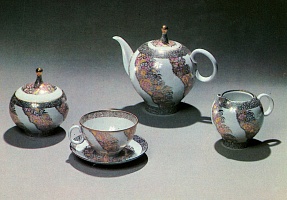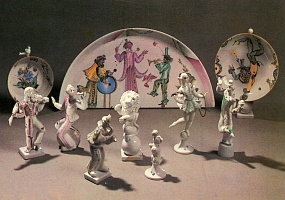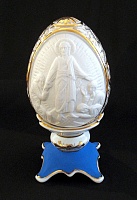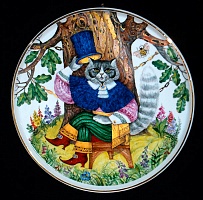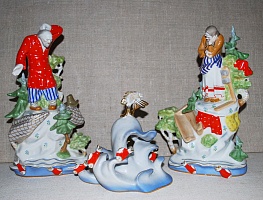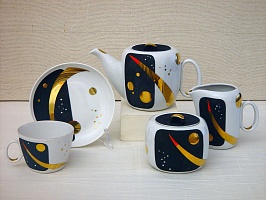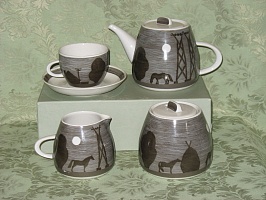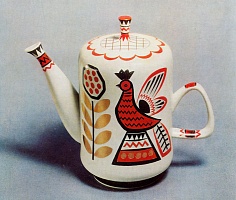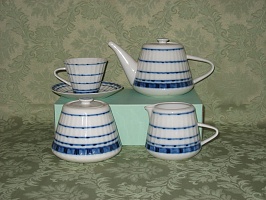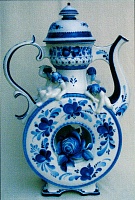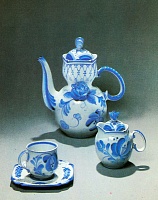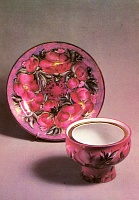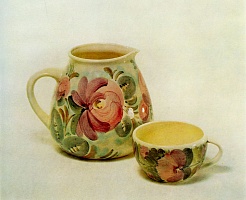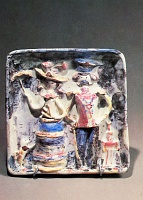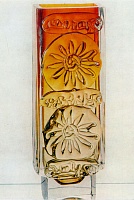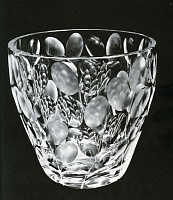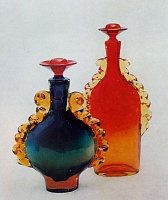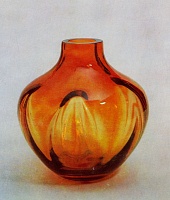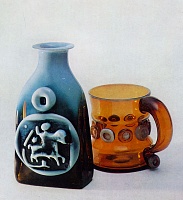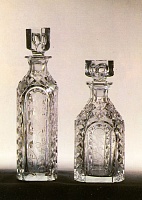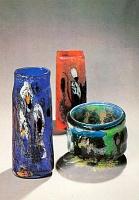Сeramics and Glass of the 20th – 21st centuries.
The Sergiev Posad Museum-Reserve contains about 7 000 items of the 20th - 21st century porcelain and glass. Collecting started in the 1950s, when specimens of contemporary folk art and crafts were actively acquired. In 1967, the new section “Soviet applied and decorative art” was opened. During the 1960s-1980s. samples of porcelain and glass came from the Directorate of Art Funds and Monument Design, from the All-Union Industry and Art Enterprise. They were selected at the exhibitions, acquired by the Museum, donated by the authors themselves.
Thus, the Museum formed a comprehensive collection of ceramics and glass, including works created by the leading artists. The exhibits mainly date back to the 1960s. Most valuable are unique exhibition specimens. The leading positions in Russian porcelain history are occupied by the Lomonosov (Imperial) Porcelain Plant in Leningrad and two Moscow region enterprises: the Dmitrov Porcelain Plant (former Gardner’s Factory) and the Dulevo Porcelain Plant named after “Pravda” newspaper (former Kuznetsov’s Factory). They represent two bright schools with their styles, traditions and high culture of the material treatment.
The Moscow plants stuck to the folk tradition. They were engaged in mass production. Leningrad porcelain developed within European trends of highly professional art of the 18th – 19th centuries. In Soviet time the Leningrad plant was an artistic creative laboratory. The works of the Leningrad Porcelain Plant are characterized by exquisite artistic taste and classical sense of proportion. They are distinguished by purity and softness of forms, pure colors and superb technique of painting.
The tea set "Cobalt Net" with elegant blue and gold ornament on the snow-white background ( form "Tulip" by S. Yakovleva, painting by A. Yatskevich ) was very popular and universally recognized. Its original decoration was new for that time. The ornament was painted with a special “ cobalt pencil” instead of a brush. N. Slavina’s drawings covered porcelain like thin lace. In the set “Blue Evening” cobalt was combined with silver. The delicate graphic ornaments and additional articles: candlesticks and small items of cut glass – are very refined.
The Dulevo new style was closely connected with the name of P. V. Leonov. His set “Golden Deer” was a pride of the Soviet decorative art. The shiny color-range, dynamic composition, schematic “tree of life” and running deer conveyed the author’s deep perception of the national cultural traditions.
In the 1960s, V. K. Yasnetsov became one of the leading Dulevo artists. A significant place in the collection is occupied by the works of artists who came to the factory in the 1970s-1980s. The works of N. N. Popova, G. I. Sorkina, M.M. Abrubov, G. N. Abrubova preserved and developed the inherited traditions in terms of the contemporary trends.
The Dmitrov ("Verbilki") Porcelain Plant prefers graphic style in ornaments. Thematic monochrome drawings present a separate group. Sometimes graphic drawings are combined with bright painting. Fantastic birds, flowers, genre scenes, town emblems are frequent ornamental elements of the sets, gift collections and souvenirs. A lot of shapes were designed by sculptors Yu. B. Ganrio and V. N. Olshevsky for artistic and mass products in the 1960s. They were used for the numerous variants of painting represented in the Museum collection.
Y. B. Ganrio is justly regarded a founder of the shape design in Soviet everyday porcelain. The tea sets "Quantum" and "Sailor" are considered his best works remarkable for laconic forms, harmonious details, fine silhouettes. Both sets were awarded the second and the third prizes correspondingly for the best industrial product at the competition announced by the magazine "Decorative Art in the USSR" in 1971.
Gzhel occupies a special place in Russian ceramics. The works of Gzhel craftsmen reveal traces of the ancient pottery traditions. But in the 20th century, all Gzhel products acquired a new artistic image. They are distinguished by beautiful underglaze cobalt painting.
The Sergiev Posad Museum-Reserve numbers over 500 Gzhel items of the 20th century. They are original works, performed by the leading artists – L. P. Azarova, Z.V. Okulova, N. B. Klinitskaya, A. N. Fedotov, V.I. Avdonin, P. N. Gordeyev, G. V. Denisov, and others, as well as, samples of mass production of the famous ceramic handicraft center.
The Museum also presents porcelain from Kuzyayevo (Moscow region), Khaitinsk (Irkutsk region), Pervomaisky (Novgorod region) and "Krasny Farforist" and "Proletarian" Plants.
The variety of famous Konakovo Faience works, decorated with bright colored glazes, complete the collection.
The collection of ceramics includes a considerable number of original works created by the artists of Moscow, Moscow region and Leningrad.
The works of glass and cut crystal in the Museum collection reflect different trends in Russian glass-making. Table sets, decorative vases and plastic compositions were created with the help of different techniques and technologies.
One of the oldest cut glass plants – Gus-Khrustalny (Vladimir region) is represented by the works of the leading artists of E. I. Rogov, S. P. Verin, V. V. Korneyev, S. K. Pivovarov, V. A. Filatov, V. S. Muratov, tenting to use techniques of folk glass-making. They are distinguished by an inexhaustible fantasy and superb skill.
The national traits in glass appear vividly in blown small-size sculptures that became an independent field of glass- making in the second half of the 20th century. The sculptures “Horse” and “Bison” designed by V. S. Muratov and blown by R.V. Chukanov are beautifully colored and expressive.
The “Krasny Mai” Glass Plant (Vyshnevolochek district, Tver region) became very famous for sulfide and sulfide and zinc glass. It was invented in 1958 by a Leningrad technologist Evgeniya Ivanova and an engineer Alexander Kirjenen – a Krasny Mai dynasty glass-maker. Sulfide glass is called “ a Russian miracle” for the unlimited range of color tints and transparency depending on temperature and treatment timing. The Museum displays works of outstanding artists A.M. Silko, S.M. Beskinskaya, etc.
Following the example of the “Krasny Mai”, where sulfide glass became a kind of brand, the Dyatkovo Cut Glass Plant started to use it for souvenirs. V. Ya. Shevchenko worked in this field. His large bottles and vases with plastic details, prints and some magic signs remind of the original properties of this wonderful material.
The Museum also presents works of two glass plants of the Novgorod region: the Plant named after the First Communist Volunteer Corps in the village of B. Vishera, and the "Rebellion" Plant in the town of Chudovo.
The Museum is proud of the significant collection of the Leningrad Plant of Artistic Glass. It is connected with such outstanding artists as L.O. Yurgen A. A. Antvatsaturian, A. M. Ostroumov, E. V. Yanovskaya, Kh. M. Pyld, B. A. Eremin,
Y. M. Byakov. The exhibits of cut glass demonstrate a " classical " line, based on traditional techniques – the wide facet, diamond facet, engraving, "Venetian thread". In the "Hunting" set E. Yanovskaya turned the diamond facet and engraving from decoration technique to the means of artistic expressiveness, evoking associations with the states of nature.
Alongside with the products of the traditional centers of Russian glassmaking, the Museum displays the unique works, created by the artists of Moscow, St. Petersburg (Leningrad) and other towns.









